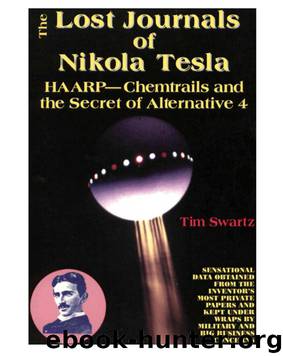Tim Swartz by The Lost Journals of Nikola Tesla

Author:The Lost Journals of Nikola Tesla [Tesla, The Lost Journals of Nikola]
Language: deu
Format: epub
Published: 2007-09-14T12:00:36+00:00
The Lost Journals of Nikola Tesla
Tesla's concept of a electrogravitic aircraft originally conceived in
1919. "I am now planning aerial machines devoid of sustaining
planes, ailerons, propellers and other external attachments, which
will be capable of immense speeds."
91
The Lost Journals of Nikola Tesla
The power plant for this machine can be a nuclear fission or fusion reactor for
long range and long-term use to run a steam engine which turns the generators.
A short range machine can use a hydrogen oxygen fuel cell to run a
low-voltage motor to turn the generators, occasionally recharging by hovering
next to high voltage power lines and using antennas mounted on the outer hull
to take in the electricity. The short-range machine can also have electricity
beamed to it from a generating plant on a long-range aircraft/spacecraft or on
the ground.
One standard for the generators is to have the same number of magnets as field
coils. Tesla's preferred design was a thin disc holding 480 magnets with 480 field
coils wired in series surrounding it in close tolerance. At 50 revolutions per
minute, it produces 19,400 cycles per second.
The electricity is fed into a number of large capacitors, one for each metal
sheet. An automatic switch, adjustable in timing by the pilot, closes, and as the
electricity jumps across the switch, back and forth, it raises it's own frequency
a switch being used for each capacitor.
The electricity goes into a Tesla transformer; again, one transformer for
each capacitor. In an oil tank to insulate the windings and for cooling, and
supported internally by wood, or plastic, pipe and fittings, each Tesla transformer
looks like a short wider pipe that is moved along a longer, narrower pipe by an
insulated non-electric cable handle. The short pipe, the primary, is six to ten
windings (loops) of wire connected in series to the long pipe. The secondary is
460 to 600 windings, at the low voltage and frequency end.
The insulated non-electric cable handle is used through a set of automatic
controls to move the primary coil to various places on the secondary coil. This
is the frequency control. The secondary coil has a low frequency and voltage end
and a maximum voltage and frequency end. The greater the frequency the
electricity, the more it pushes against the earth's electrostatic and electromagnetic
fields.
The electricity comes out of the transformer at the high voltage end and
goes by wire through the ceramic hull to the wide end of the metal sheet. The
electricity jumps out on and flows over the metal sheet, giving off a very strong
electromagnetic field, controlled by the transformer. At the narrow end of the
metal sheet, most of the high-voltage push having been given off, the electricity
goes back by wire through the hull to a circuit breaker box (emergency shut off).
92
The Lost Journals of Nikola Tesla
In bright sunlight, the aircraft/spacecraft may seem surrounded by hot air,
a slight magnetic distortion of the light. In semi-darkness and night, the metal
sheets glow, even through the thin ceramic outer hull, with different colors. The
visible light is a by-product of the electricity flowing over the metal sheets,
according to the frequencies used.
Descending, landing or just starting to lift from the ground, the
Download
This site does not store any files on its server. We only index and link to content provided by other sites. Please contact the content providers to delete copyright contents if any and email us, we'll remove relevant links or contents immediately.
Hit Refresh by Satya Nadella(9083)
When Breath Becomes Air by Paul Kalanithi(8368)
The Girl Without a Voice by Casey Watson(7848)
A Court of Wings and Ruin by Sarah J. Maas(7732)
Do No Harm Stories of Life, Death and Brain Surgery by Henry Marsh(6906)
Shoe Dog by Phil Knight(5219)
The Rules Do Not Apply by Ariel Levy(4911)
A Higher Loyalty: Truth, Lies, and Leadership by James Comey(4907)
Hunger by Roxane Gay(4893)
Tuesdays with Morrie by Mitch Albom(4732)
Everything Happens for a Reason by Kate Bowler(4702)
The Immortal Life of Henrietta Lacks by Rebecca Skloot(4550)
Millionaire: The Philanderer, Gambler, and Duelist Who Invented Modern Finance by Janet Gleeson(4425)
How to Change Your Mind by Michael Pollan(4315)
All Creatures Great and Small by James Herriot(4271)
The Money Culture by Michael Lewis(4135)
Man and His Symbols by Carl Gustav Jung(4095)
Elon Musk by Ashlee Vance(4084)
Tokyo Vice: An American Reporter on the Police Beat in Japan by Jake Adelstein(3951)
